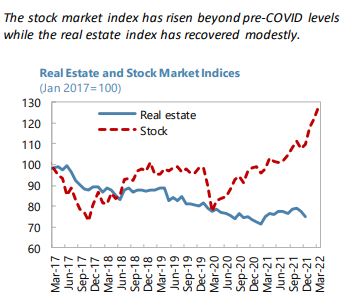Showing posts with label Global Housing Watch. Show all posts
Friday, June 24, 2022
Housing View – June 24, 2022
On cross-country:
- The World’s Bubbliest Housing Markets Are Flashing Warning Signs. Global monetary tightening is squeezing homebuyers, adding risks that a slowdown could ripple through the economy. – Bloomberg
- The property industry has a huge carbon footprint. Here’s how to reduce it. Some buildings should be retrofitted, others torn down – The Economist
On the US:
- America Faces a Housing Bust. All ingredients seemed in place at 2022’s start for a continued housing boom, but now the market has priced itself for a sharp reversal – Wall Street Journal
- The State of the nation’s Housing 2022 – Joint Center for Housing Studies of Harvard University
- Is another housing crash on the way? – The Economist
- Investors’ Housing Bets Are on Shaky Foundations. Cash has been pouring into residential property on the assumption that an unprecedented run up in rents will continue – Wall Street Journal
- We’re Already Seeing the Stock Market Selloff Spill Into the Housing Market. It’s especially notable in places where stock-based comp is significant. – Bloomberg
- U.S. labor market appears to cool; homebuilding slumps as rates surge – Reuters
- US Housing Starts Decline to Lowest Level in More Than a Year. May construction fell to 1.55 million pace after April surge. Builder backlogs remain elevated even as sales decrease – Bloomberg
- Housing Just Hit a Wall. What’s Next for Prices, Brokers, and Builder Stocks. – Barron’s
- Work From Home and the Office Real Estate Apocalypse – SSRN
- The Size and Census Coverage of the U.S. Homeless Population – NBER
- Housing’s Slowdown Has Economy on the Edge. News of a cooling housing market might be a relief to some, but we’ll be living with the aftereffects for a long time to come. – Bloomberg
- Hot Housing Market Keeps Home Foreclosures at Bay. Robust home prices and government relief programs are giving financially squeezed homeowners options to avoid foreclosure – Wall Street Journal
- US House Prices Are Likely to Drop as Rates Rise, Capital Economics Says – Bloomberg
- The Left-NIMBY meltdown. It’s getting harder to pretend that blocking new housing helps poor people. – Noah Smith
- Cancel Zoning. If we want to fix the housing-affordability crisis, segregation, and sprawl, zoning must go – The Atlantic
- In Pursuit of Affordable Housing: The Migration of Homebuyers within the U.S.—Before and After the Pandemic – Freddie Mac
On China
- China’s Once-Sizzling Property Market Has Started to Cool. New home prices in China have fallen, and would-be buyers are thinking twice. That’s bad news for the overall economy. – New York Times
- Chinese Developer Accepts Wheat, Garlic as Payment to Woo Buyers – Bloomberg
- China’s Property Slump Is a Bigger Threat Than Its Lockdowns. The worst decline on record could hold growth below 4% for the rest of the decade. – Bloomberg
On other countries:
- [Australia] Sydney house prices still 20% above pre-pandemic levels despite rising interest rates. Economists say while property prices could come down by up to 20%, affordability has ‘never been worse’ – The Guardian
- [Australia] Sales slow down in Sydney’s suburbia-on-sea. After a period of rising prices, homebuyers are starting to get more for their money, while some sellers lose out – FT
- [Canada] Distressed Deals Pile Up in Canada’s Once-Booming Housing Market. Prices are falling in some of the urban markets that had the biggest increases over the past two years. That’s leading to broken and renegotiated deals. – Bloomberg
- [Israel] Israel lawmaker seeks larger mortgage loans as home buyers priced out – Reuters
- [Sweden] Sweden’s Housing Bubble Deflates as Realtors Sound Alarm – Bloomberg
- [United Kingdom] Are the Days of UK Property Booms and Busts Over? Tougher mortgage regulation in 2014 sought to contain overstretched buyers. Its effectiveness is about to be put to the test. – Bloomberg
- [United Kingdom] Bank of England to Get Rid of Mortgage Affordability Rules. UK central bank will end the affordability test from Aug. 1. The BOE raised the benchmark interest rate last week to 1.25%. – Bloomberg
On cross-country:
- The World’s Bubbliest Housing Markets Are Flashing Warning Signs. Global monetary tightening is squeezing homebuyers, adding risks that a slowdown could ripple through the economy. – Bloomberg
- The property industry has a huge carbon footprint. Here’s how to reduce it. Some buildings should be retrofitted, others torn down – The Economist
On the US:
- America Faces a Housing Bust.
Posted by at 5:00 AM
Labels: Global Housing Watch
Tuesday, June 21, 2022
Housing Market in Greece
From IMF’s latest report on Greece:
“There are nascent signs of emerging systemic vulnerabilities. Residential real estate prices have rebounded by almost 25 percent since 2018, accompanied by a significant increase in price-to-rent and income ratios. Commercial real estate prices have also rebounded, albeit to a weaker extent. Household credit expansion has surpassed disposable income growth, with demand for mortgage and corporate loans expected to mirror the recent rise in new lending to households and corporates, although after a period of pronounced private sector deleveraging (…). Model-based analyses suggest positive private sector credit gaps for Greece. A further acceleration of credit growth is anticipated from NGEU loans being channeled through the banking system.”
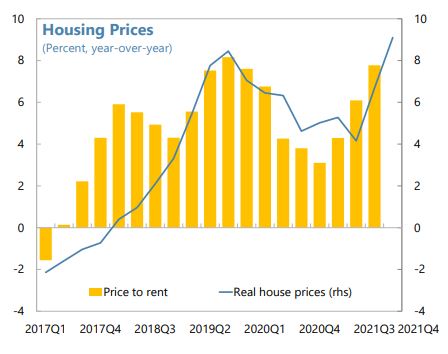
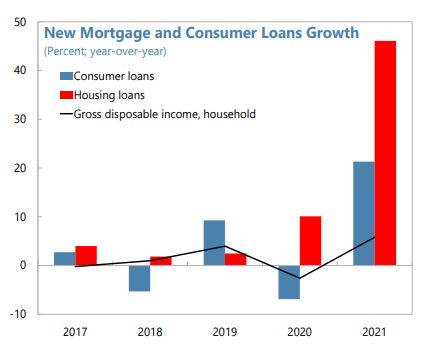
From IMF’s latest report on Greece:
“There are nascent signs of emerging systemic vulnerabilities. Residential real estate prices have rebounded by almost 25 percent since 2018, accompanied by a significant increase in price-to-rent and income ratios. Commercial real estate prices have also rebounded, albeit to a weaker extent. Household credit expansion has surpassed disposable income growth, with demand for mortgage and corporate loans expected to mirror the recent rise in new lending to households and corporates,
Posted by at 8:53 PM
Labels: Global Housing Watch
Housing Market in Qatar
Posted by at 8:48 PM
Labels: Global Housing Watch
Monday, June 20, 2022
Housing Market in Switzerland
From the IMF’s latest report on Switzerland:
“With further housing price increases, the sectoral CCyB was reactivated at the maximum 2.5 percent, effective September 2022. (…) This has alleviated downward inflation pressures, but brought side-effects (balance-sheet expansion, profitability pressures, higher housing prices). (…) Housing prices have risen relative to fundamentals (overvaluation estimates are 5–30 percent for apartments), with search-for-yield and robust mortgage lending. A sharp tightening of conditions could trigger sell-offs in the investment-led segment and increase affordability concerns in general. Price corrections could lead to defaults and pressures on capital buffers. Domestically-focused banks are vulnerable to interest-rate shocks, given duration gaps; the largest banks are exposed to international clients via leveraged and Lombard loans, to counterparty credit risk in derivative and trading activities, to market and basis risk (under volatile conditions), and to business risk from lower asset management flows, including linked to the war in Ukraine. Risks related to crypto assets and cyberattacks have increased with the war, although incidents have remained contained; sanctions have increased compliance and financial-integrity risks.”
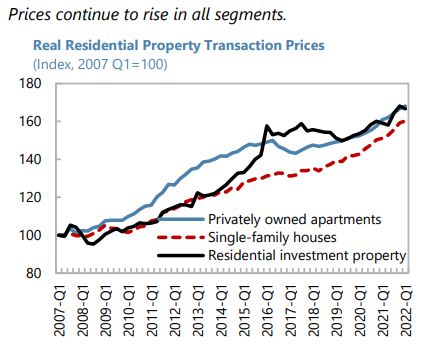
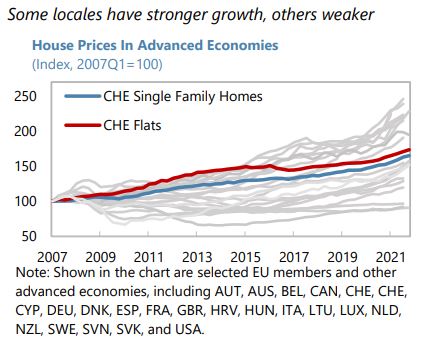
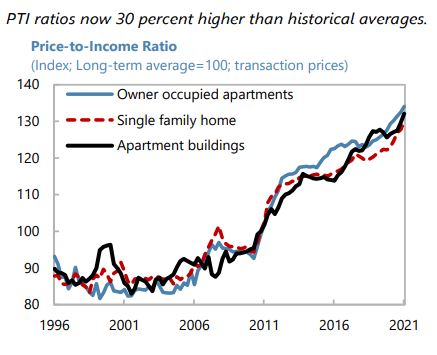

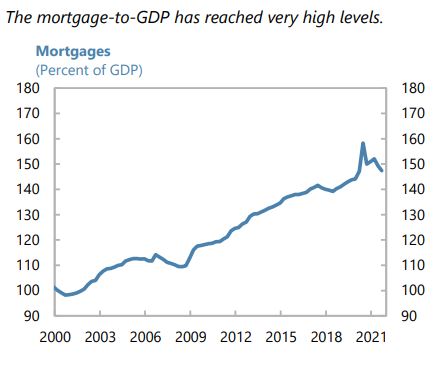
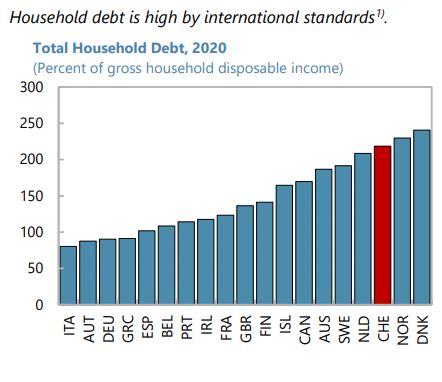
From the IMF’s latest report on Switzerland:
“With further housing price increases, the sectoral CCyB was reactivated at the maximum 2.5 percent, effective September 2022. (…) This has alleviated downward inflation pressures, but brought side-effects (balance-sheet expansion, profitability pressures, higher housing prices). (…) Housing prices have risen relative to fundamentals (overvaluation estimates are 5–30 percent for apartments), with search-for-yield and robust mortgage lending. A sharp tightening of conditions could trigger sell-offs in the investment-led segment and increase affordability concerns in general.
Posted by at 9:33 AM
Labels: Global Housing Watch
A Forward Looking Approach to Calibrate Macroprudential Tools in Switzerland
From the IMF’s latest report on Switzerland:
“Housing matters for economic activity and financial stability in Switzerland. The mortgage market is large relative to the size of the economy and banks are heavily exposed. House prices have significantly outpaced income growth, and this trend has accentuated during the pandemic. The Swiss authorities have taken decisive action to address unsustainable developments, but vulnerabilities have increased. This paper shows that a fuller set of macroprudential tools can be more effective to reduce systemic risk. Adequate calibration and a forward-looking approach are key given lags between policy announcements and policy effects. The paper quantifies a suite of LTV/DSTI caps, amortization requirements, and ‘speed limits’ calibrated at the vintage level to guard against the build-up of vulnerabilities and strengthen resilience.”
From the IMF’s latest report on Switzerland:
“Housing matters for economic activity and financial stability in Switzerland. The mortgage market is large relative to the size of the economy and banks are heavily exposed. House prices have significantly outpaced income growth, and this trend has accentuated during the pandemic. The Swiss authorities have taken decisive action to address unsustainable developments, but vulnerabilities have increased. This paper shows that a fuller set of macroprudential tools can be more effective to reduce systemic risk.
Posted by at 9:24 AM
Labels: Global Housing Watch
Subscribe to: Posts
